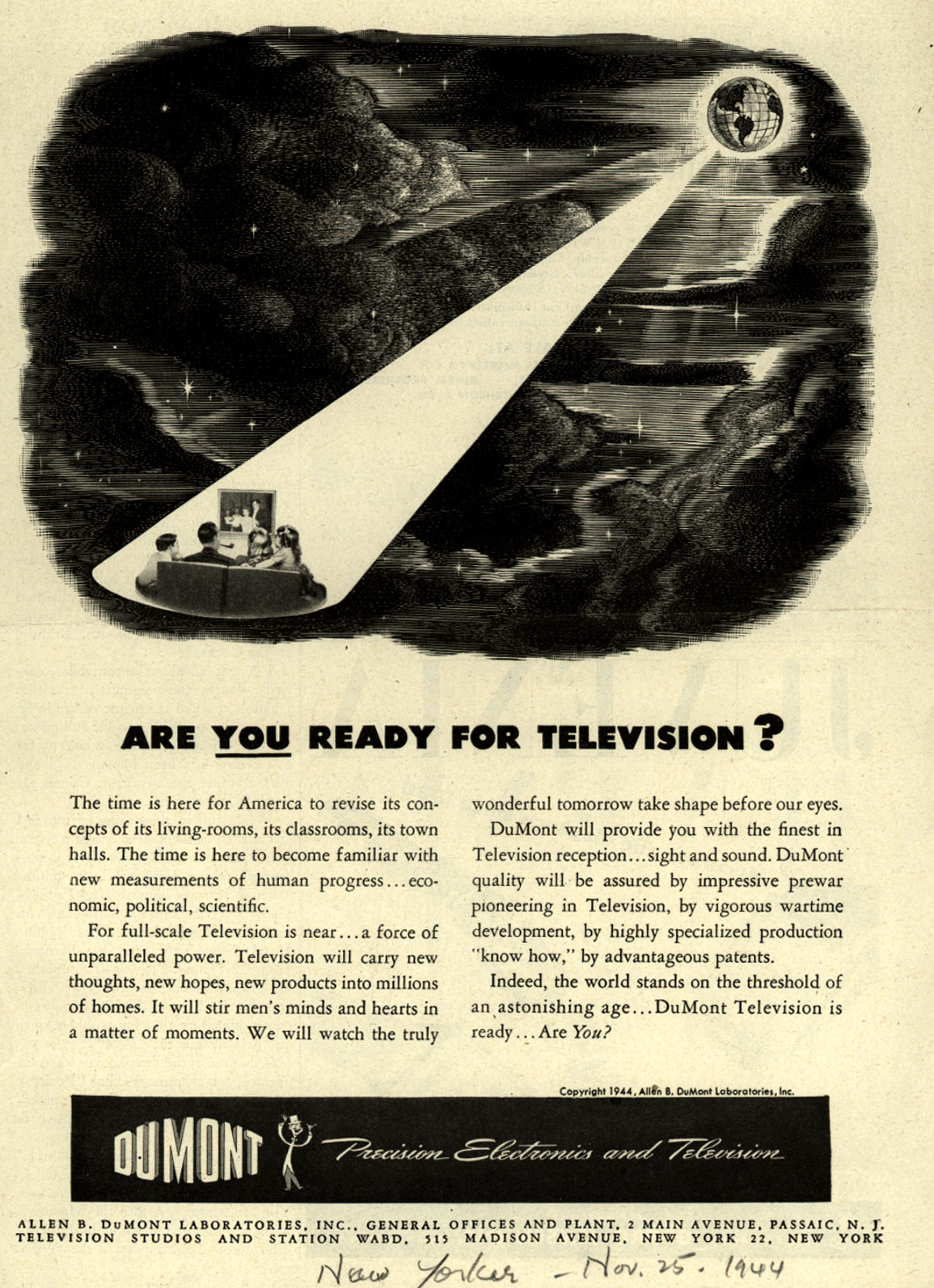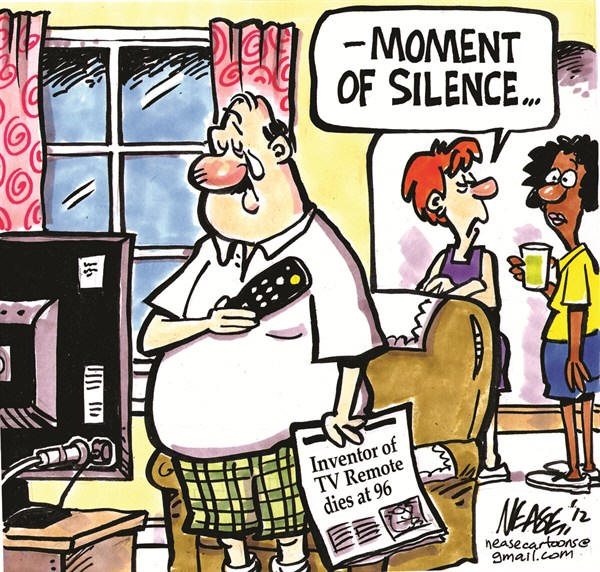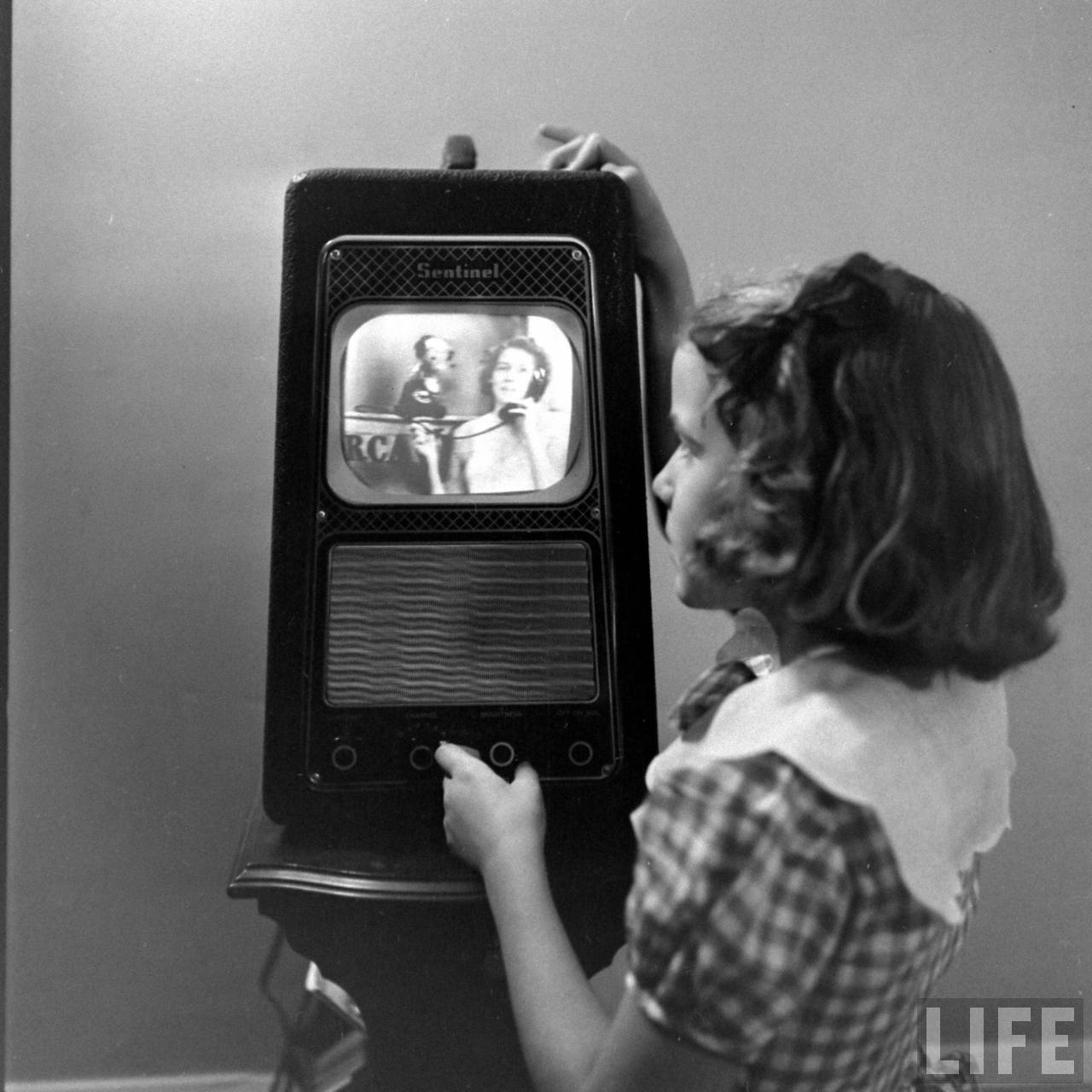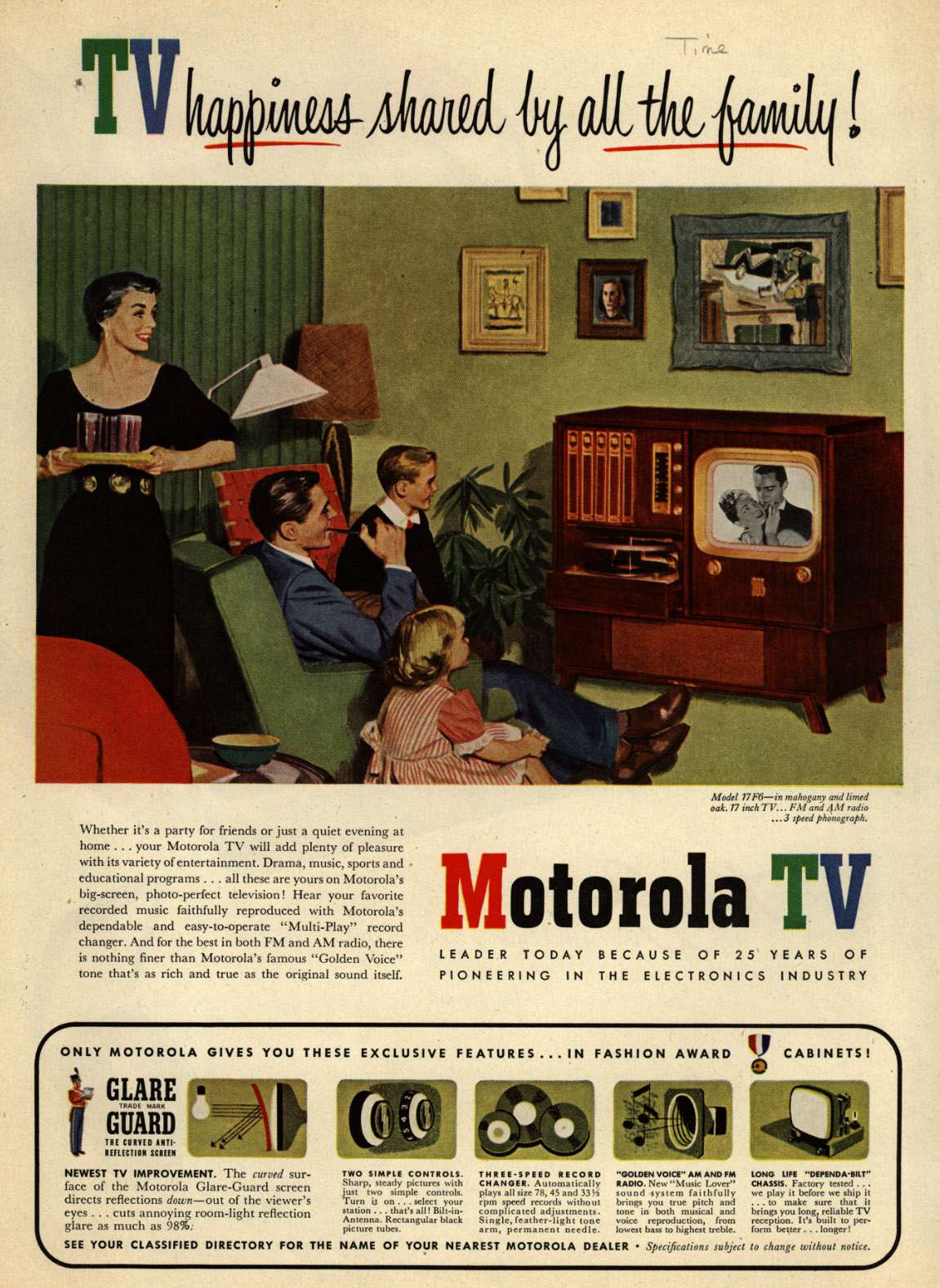|
Vocapedia >
Media
> Television > Broadcasting
The Race for the 4K Television Audience
Video Molly Wood The New
York Times 10 October 2014
Retailers are soon going to be making
a big push for 4K
televisions,
but the content is still lacking.
Molly Wood visits one company
that hopes to become the Netflix of 4K by being there first.
Produced by: Molly Wood and Vanessa Perez
Read the story here: http://nyti.ms/1neorZ9
Watch more videos at:
http://nytimes.com/video
YouTube
https://www.youtube.com/watch?
v=ZO2DclGxZsc&list=UUqnbDFdCpuN8CMEg0VuEBqA&index=7

Are You Ready for Television?
Collection: Ad*Access
Company: Allen B. DuMont Laboratories, Inc.
Product: Television
Publication: New Yorker
Publication Type: Magazine
Year: 1944
Number of Pages: 1
Subject: Television--DuMont
Illustration--Drawing
Item Number: TV0073
Duke University
http://library.duke.edu/digitalcollections/adaccess.TV0073/
http://library.duke.edu/digitalcollections/adaccess/

Steve Nease
cartoon
Cagle
23 May 2012
For nearly nearly 30 years until 2008,
Steve Nease was the art director
at
The Oakville Beaver,
producing regular editorial cartoons
and his family comic
strip, Pud.
television USA
have a television
USA
https://www.nytimes.com/2019/07/20/
science/apollo-11-television.html
TV USA
https://www.nytimes.com/2017/01/11/
technology/how-netflix-is-deepening-our-cultural-echo-chambers.html
TV set
television set
remote control
UK
http://www.theguardian.com/media/2005/apr/28/
broadcasting.bbc
death of the analogue television set
UK
6 July 2010
http://www.guardian.co.uk/media/2010/jul/06/
analogue-television-digital-switchover
flat screen
interactive
3-D TV USA
http://www.nytimes.com/2010/02/04/
technology/personaltech/04basics.html
4K Television
https://www.youtube.com/watch?
v=ZO2DclGxZsc&list=UUqnbDFdCpuN8CMEg0VuEBqA&index=7
Internet-enabled televisions
USA
http://www.nytimes.com/2012/04/28/business/
media/developers-are-working-on-television-apps-but-tv-industry-is-wary.html
apps for television
USA
http://www.nytimes.com/2012/04/28/
business/media/developers-are-working-on-television-apps-but-tv-industry-is-wary.html
digital switchover UK
https://www.theguardian.com/media/digital-switchover
remote control / remote
screen
screen
UK
http://www.guardian.co.uk/media/2009/mar/26/
condom-ads-television
broadcast
broadcast
broadcast TV USA
https://www.npr.org/2021/05/10/
994616279/underground-railroad-director-barry-jenkins-sees-film-as-an-empathy-machine
https://www.nytimes.com/2017/01/11/
technology/how-netflix-is-deepening-our-cultural-echo-chambers.html
over-the-air broadcast era
USA
https://www.nytimes.com/2017/01/11/
technology/how-netflix-is-deepening-our-cultural-echo-chambers.html
broadcaster
UK
https://www.theguardian.com/books/2020/oct/23/
what-now-for-the-bbc
broadcasting USA
https://www.nytimes.com/2017/01/11/
technology/how-netflix-is-deepening-our-cultural-echo-chambers.html

Portable Television Set
Date taken: October 1948
Photographer: George Skadding
Life Images

TV happiness shared by all the family!
Collection: Ad*Access
Company: Motorola Inc.
Product: Model 17F6
Publication: Time
Publication Type: Magazine
Year: 1951
Number of Pages: 1
Subject: Television--Motorola
Illustration--Painting
Illustration--Drawing
Children
Item Number: TV0213
Duke University
http://library.duke.edu/digitalcollections/adaccess.TV0213/
http://library.duke.edu/digitalcollections/adaccess/
In Search of Apps for Television
April 27, 2012
The New York Times
By AMY CHOZICK
and NICK WINGFIELD
The same consumers who delight in navigating the iPad still
click frustratingly through cable channels to find a basketball game. Their
complaint: Why can’t television be more like a tablet?
The technology industry is trying to address that question for the millions of
customers ready to embrace the next generation of viewing options. In the
process it could transform the clunky cable interface, with its thousands of
channels and a bricklike remote control, into a series of apps that pop up on
the television screen.
While still in its early stages, the idea has taken off among tech-loving
consumers, and companies are trying to satisfy them. Already, apps for Hulu
Plus, Netflix and Wal-Mart’s Vudu streaming service, among others, are built
into Internet-enabled televisions. Devices like Microsoft’s Xbox 360 and the
streaming video player Roku let viewers watch apps that mimic channels. New sets
by Samsung and others come with built-in apps loaded with television shows,
movies and sports.
Apple has a video player called Apple TV with apps to Netflix, Major League
Baseball and other content. Many media executives predict Apple will ultimately
enter the television market in a more aggressive way, with either a new set-top
box or an Apple-made TV set. Both would rely on apps scattered across the screen
as they are on the iPad. Apple declined to comment.
“I’ve told my bosses, ‘This is beachfront real estate. Buy in now,’ ” Lisa Hsia,
executive vice president of digital media at NBCUniversal’s Bravo channel, said
of developing TV apps.
A model built around TV apps, however, could let viewers use favorite apps on
the screen on an á la carte basis, thus bypassing cable subscriptions and all
the extraneous channels they don’t watch. And therein lies the tension that has
the television industry delicately assessing how to balance the current system
with an Internet-based future that some feel is inevitable.
“The question that hasn’t yet been answered is whether television viewing will
consist of a single app that mimics the pay TV bundle or a series of different
apps that together form a content experience,” said Jon Miller, the chief
digital officer at News Corporation, which owns Fox Broadcasting and cable
channels like Fox News and FX.
Ŕ la carte apps would upend the entrenched and lucrative economics of
television, which have long relied on a system in which cable customers pay for
channels even if they don’t watch them.
The so-called bundle setup helps little-watched channels bring in revenue from
monthly cable fees and allows the most popular channels to get high fees from
every subscriber, even the ones who don’t watch them.
The idea of undermining this model is so sensitive that media executives who
think that apps are the future of television would not discuss the subject
publicly, for fear of disturbing their cable and satellite partners.
But many analysts caution against predicting the near-term demise of cable and
satellite delivery, pointing out that the spending and viewing habits of
consumers are also firmly entrenched.
“The model we have is the model we have, and while it’s tempting to imagine an
app for TNT and an app for ESPN, that’s not the likely outcome,” said Craig
Moffett, an analyst at Sanford C. Bernstein & Company. Ŕ la carte apps might
seem like a bright idea, Mr. Moffett said, but it is unlikely consumers would
pay $20 a month for individual channels when the traditional cable bundle
provides a bargain price.
Currently, most TV apps created by networks work on an authentication model that
requires cable subscribers to log in before gaining access to a channel’s app.
The handful of apps already available on television screens also largely require
a cable subscription.
For the most part, the apps being offered today are intended as complements to
traditional TV viewing and are available only on tablets and mobile devices. For
instance, NBC Sports will soon introduce its NBC Olympics Live Extra app, which
will allow subscribers to stream every Olympic event from London this summer. It
is available only on iPads, tablets and other mobile devices, not on TV screens
through Xbox or Roku.
“No one on the digital side wants to take away audience from the TV,” said Rick
Cordella, vice president and general manager for NBC Sports Digital.
Time Warner’s HBO still relies heavily on the cable bundle because it does not
have the customer service or sales force of a company like Comcast or Time
Warner Cable. But HBO Go does allow subscribers to have access to the pay
channel’s library of almost every series, movie, documentary and heavyweight
fight directly on the TV screen, via the Xbox.
“The HBO Go app is seen as a doorway into the entire world of HBO programming,”
said Eric Kessler, co-president at HBO. “That adds tremendous value to the
subscription.”
As such, HBO Go could help the channel lay the groundwork to eventually break
out on its own on an ŕ la carte basis, even if that might not happen soon, said
James McQuivey, an analyst at Forrester Research. “HBO has the largest
subscriber base of any video service in the world, but they know none of their
customers by name,” Mr. McQuivey, said. “That will be a huge liability in the
future. HBO knows that; that’s why they need a direct relationship.”
The ability of any channel to strike out on its own, even strong ones like HBO
or the Walt Disney Company’s ESPN, remains problematic. ESPN makes about $5 a
month from each of the country’s more than 100 million cable subscribers. If
ESPN ever sold its live sports and talk shows directly to the consumer, it would
need to charge several times that rate. “We have no plans to bisect our
partnerships with distributors,” said Sean Bratches, the ESPN executive vice
president for sales and marketing.
But just as with previous transformations in television, the economics will have
to catch up as technology evolves, said Jeremy Allaire, chief executive of
Brightcove, a technology firm based in Boston that builds apps for media
companies.
By 2014, an estimated 89.5 million people in the United States will use tablet
computers, up from 54.8 million users in 2012, according to the research firm
eMarketer. “You have to achieve scale before the economics will work,” Mr.
Allaire said. “But at some point, we think direct-to-consumer will be very
important.”
That model may prove attractive to smaller cable channels, many of whom dislike
how they are buried within the traditional electronic guides that viewers use to
navigate their cable boxes.
Bigger cable channels may find it appealing as well. The head of digital
strategy at one major channel said he was excited about the idea of having an
app that sat on the home screen of a television. It would provide a “safer
passage” to eventually sell the channel directly to customers, rather than
through a cable package, said the executive, who declined to be identified to
avoid upsetting the company’s cable partners.
Cable and satellite companies have sped up the development of their own TV apps
in the hope that they will eventually mimic the set-top box. In an ideal cable
industry model, customers will have one or two apps that offer hundreds of
channels rather than dozens of apps for individual networks. “You download all
these apps, and then you get app fatigue,” said Matt Strauss, Comcast Cable’s
senior vice president for digital and emerging platforms.
“Apps create amazing experiences,” Mr. Strauss said. “But I believe most
customers and households are still looking for an aggregated experience that’s
intuitive and personalized.”
In Search of Apps for Television,
NYT, 27.4.2012,
http://www.nytimes.com/2012/04/28/
business/media/developers-are-working-on-television-apps-
but-tv-industry-is-wary.html
A
Bonanza in TV Sales Fades Away
January 5,
2011
The New York Times
By SAM GROBART
LAS VEGAS —
By now, most Americans have taken the leap and tossed out their old boxy
televisions in favor of sleek flat-panel displays.
Now manufacturers want to convince those people that their once-futuristic sets
are already obsolete.
After a period of strong growth, sales of televisions are slowing. To counter
this, TV makers are trying to persuade consumers to buy new sets by promoting
new technologies. At this week’s Consumer Electronics Show, which opens
Thursday, every TV maker will be crowing about things like 3-D and Internet
connections — features that have not generated much excitement so far.
Unit sales of liquid-crystal and plasma displays were up 2.9 percent in 2010
from the previous year, according to figures from the market researcher
DisplaySearch. That is tiny compared with the gains of more than 20 percent in
each of the prior three years.
Those heady days of the last decade were the result of an unusual set of
circumstances. The rise of flat-panel television technologies like plasma and
LCD almost perfectly coincided with a government-mandated switchover to digital
broadcasting and the availability of high-definition shows and movies —
something these new televisions were all ready to display.
That sparked a mass migration of consumers from using the old cathode-ray tube
television sets to the thinner and lighter plasma and liquid-crystal displays.
“Those were the golden years,” Paul Gagnon, director of North American TV
research at DisplaySearch, said. “During that period, the whole pie grew.
Technology inflated the size of the category.”
But now, most people who want a flat-screen TV already own one. Industry
watchers and manufacturers estimate that nearly two-thirds of households in the
United States have a flat-screen set.
“The laggards are stubborn,” Mr. Gagnon said. “They will not move as quickly as
the rest of the market has.”
The industry’s response has been to promote 3-D and Internet capabilities. But
these were also the buzzwords at last year’s show, indicating that after a
period of consistent innovation and improvement — from higher resolutions to
thinner displays — the TV market is maturing and stabilizing.
“In the next decade, the rate of change may not be the same,” said James
Sanduski, Panasonic’s senior vice president for sales. “That said, it will still
be significant.”
So far, 3-D has not prompted a rush to upgrade. John Revie, senior vice
president for home entertainment at Samsung, said 3-D had been saddled with a
perception that it stumbled out of the gate, even though its introduction
compared favorably with other technological introductions.
“More than one million 3-D TVs were sold in 2010,” he said. “But LED, HD and
Blu-ray each sold less than a million in their first year.”
That said, Mr. Revie acknowledged the perceived shortfall. “Frankly, Samsung was
hoping to drive a bigger market.”
Some feel that 3-D’s appeal will remain limited. Riddhi Patel, director for
television systems and retail services at iSuppli, a market researcher, said the
sales pitch for 3-D was a complicated one.
“Consumers are aware of the hidden costs,” Ms. Patel said. “It’s not just the
display, but now you need a 3-D Blu-ray player and 3-D media and additional
glasses.”
She also questioned the payoff. “When everyone markets 3-D to you, they talk
about ‘Avatar’ and the theatrical experience,” she said. “When you have a
42-inch TV or even a 50-inch TV, it’s not the same experience.”
Internet features are now common in new TV models. But recent missteps by
technology companies like Google with its Google TV service, as well as the
often confusing mosaic of streaming and download providers, has left the market
looking a little muddled.
“Every manufacturer has their own way” of dealing with Internet video, Mr.
Sanduski said. “There’s not one standard.”
One way manufacturers are trying to make these features friendlier is by using
Apple’s iPhone model, allowing outside companies like Netflix to develop
applications that work on their displays. On Wednesday, Panasonic and LG
announced new Internet TV platforms that will open up the interfaces of their
sets to outside developers.
One big issue for TV makers is price. From 2007 to 2010, the average price of an
LCD TV dropped 36.3 percent, according to DisplaySearch. Plasma TV prices had an
even more precipitous decline, dropping 51.6 percent in the same period.
But those price drops have slowed recently, as manufacturers have gotten a
handle on what had been an oversupply of product and have started to charge more
for the new features.
“It’s kind of like having the auto industry trying to raise the prices of cars
by 20 percent by adding all these options to every vehicle,” Mr. Gagnon said.
In another bright spot for TV makers, consumers seem willing to upgrade their
sets more frequently than they did in the tube era, when it was not uncommon for
them to use the same sets for a decade or more. “People held on to their TV like
an appliance,” Mr. Sanduski said.
Analysts and TV makers now assume a five-to-seven-year replacement cycle for
televisions. For the manufacturers, that may feel like an awfully long time. But
it is only slightly longer than the cycle for PCs, which are replaced every
three to four years. “There’s a little bit of fatigue,” Mr. Sanduski said. “Many
consumers are saying, ‘I just bought a TV. I’m going to wait.’ ”
A Bonanza in TV Sales Fades Away,
NYT, 5.1.2011,
http://www.nytimes.com/2011/01/06/technology/06sets.html
Related > Anglonautes >
Vocapedia
media,
press,
newspapers, radio, TV,
journalism,
photojournalism,
free speech,
free press,
fake news,
misinformation,
disinformation,
cartoons, advertising
TV > media,
journalism
TV > shows, series
Related > Anglonautes > Arts
television > shows / series
Related
UK > The Guardian > TV series
https://www.theguardian.com/culture/series/watchthis
USA > The Guardian > US television
https://www.theguardian.com/tv-and-radio/us-television
USA > NPR > Television
https://www.npr.org/sections/television/
USA > The New York Times > Television
https://www.nytimes.com/section/arts/television
|